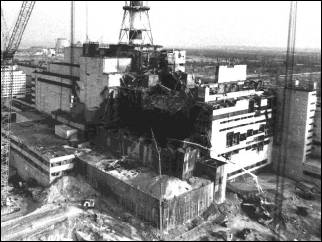KYIV, UKRAINE CONFERENCE ON 20TH ANNIVERSARY OF CHORNOBYL BRINGING TOGETHER EXPERTS FROM ACROSS THE GLOBE
April 10, 2006.

WILL FOCUS ON NEW INFORMATION ON CHORNOBYL CONSEQUENCES, FACTS ON NUCLEAR POWER TODAY & SUSTAINABLE ENERGY CHOICES
With the 20th anniversary of the Chornobyl nuclear disaster rapidly approaching, organizers of the Chornobyl+20: Remembrance for the Future conference today announced more details about conference speakers and format. The international conference will be held April 23-25, 2006 at the House of the Teacher in downtown Kyiv, Ukraine.
The conference will consist of four main sections, supplemented by numerous workshops. The first session, on Sunday, April 23, will feature an opening for the wider public with reputed Ukrainian writers and poets, introduced by European Parliament member Rebecca Harms. Among the speakers will be Yury Andruhovych, an internationally well-known poet, novelist and essayist, who just received the Leipzig book prize for European cooperation.
On Monday morning, scientists and experts will present a new critique of the September 2005 International Atomic Energy Agency report on Chornobyl consequences, which many believe substantially understates the devastating reality of the disaster. Led by the United Kingdom’s Dr. Ian Fairlie, coordinator of the new critique, the morning sessions will also feature Professor Alexey Yablokov, a former advisor to Russian President Boris Yeltsin; Dr. Angelina Nyagu of the Academy of Medical Sciences of Ukraine; Alex Kuzma of the Children of Chornobyl Relief Fund, Dr. Angelika Claussen of IPPNW, and many more.
Monday afternoon is devoted to highlighting the current debate on nuclear energy, addressing safety and proliferation issues as well as economic aspects of nuclear technology. Among confirmed speakers are co-authors of a new study series on the topic, Felix Matthes of the Цko Institute and independent consultant Antony Froggatt. The study was commissioned by the Heinrich Bцll Foundation and will be presented at the conference. Also featured are Vladimir Chuproff of Greenpeace Russia; Yury Urbansky of Bankwatch; and Ada Amon of Energia Klub in Budapest, and many more.
Tuesday’s session, entitled “Roadmap to a Sustainable Energy Future” will draw on the potential role of renewable energy sources as well as energy efficiency strategies while at the same time taking into consideration the specific energy policy realities in Ukraine and other Central and Eastern European countries. Featured experts of the sessions include, among others, author and researcher Hunter Lovins of Natural Capitalism; Ed Smeloff, former chief of the San Francisco and Sacramento electric utilities; Andriy Konechenkov of Renewable Energy Agency in Ukraine; Professor Victoria Vereshchak of Dnepropetrovsk University, and German MP Reinhard Loske, Alliance 90/The Greens.
The conference will conclude Tuesday afternoon with a press conference and an afternoon NGO networking session for environmental and grassroots groups from across the world.
More speakers will be announced over the next few weeks. Registration for Chornobyl+20: Remembrance for the Future can be done through the conference website, www.ch20.org. The website also includes background material on Chornobyl and the issues to be raised at the conference, information on the conference organizers, and regularly updated program and speaker information.
BACKGROUND—CHORNOBYL CONSEQUENCES
The disaster at Chornobyl was a unique industrial accident due to the scale of its social, economic and environmental impacts and their longevity. It is estimated that, in Ukraine, Belarus and Russia alone, around 9 million people, among them about 3 million children, were directly affected resulting from the fact that the long lived radioactivity released was more than 200 times that of the atomic bombs dropped on Hiroshima and Nagasaki.
Across the former Soviet Union the contamination resulted in evacuation of some 400,000 people. About 200,000 km2 of land was, and is, contaminated by radioactive Caesium-137 above 37kBq/m2 (intervention level). In addition, about 3,900,000 km2, about 40% of the surface area of Europe, was contaminated above the level of 4 kBq/m2. This contamination will persist for centuries, and many countries as well as Belarus, Ukraine and Russia will need to continue with food restriction orders for many decades to come. The economic consequences of the accident remain a massive burden on the countries most affected; Ukraine and Belarus continue to spend around 6% of their Gross National Product on trying to deal with the consequences of the accident.
The full health impact of the Chornobyl disaster might never be known. Although official accounts point to 4,000 expected cancer deaths from Chornobyl in Belarus, Ukraine and Russia, the real prediction in IAEA/WHO reports is more than 9,000 cancer deaths. However this excludes the more than 30,000 anticipated cancer deaths from the collective doses in all other countries in the Northern Hemisphere. Over 6,000 thyroid cancer cases have been diagnosed so far in Belarus, Ukraine and Russia, and more are anticipated. Recent scientific studies are revealing increased incidences of solid cancers, including breast cancer, as well as cardiovascular and ophthalmic effects. These effects have long latency periods of more than 20 years. The general state of health is in decline and contaminated territories show low birth rates, relatively high rates of prenatal losses and infant mortality. The health situation is further complicated by the persisting social-economic crisis in the three most affected countries. The current medical condition of the affected population indicates that the adverse health legacy from Chornobyl is continuing and is more severe than officially admitted.
Chornobyl, is the clear and indisputable example of the possible consequences of nuclear power. It is a lesson to the world that nuclear power is too dangerous, dirty and expensive.
In the U.S., contact Michael Mariotte at Nuclear Information and Resource Service, 202.328.0002, nirsnet@nirs.org.
|




